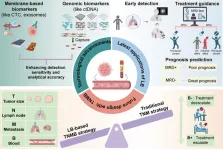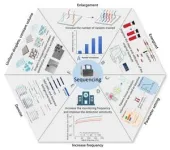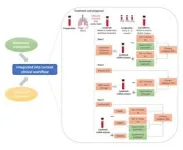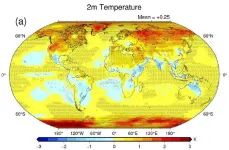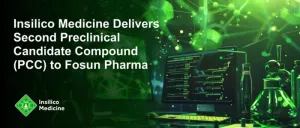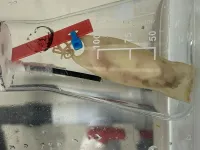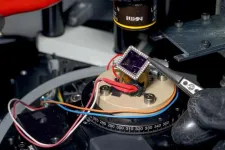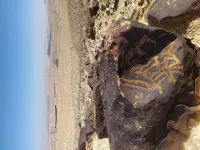(Press-News.org) This study was led by Kezhong Chen (Department of Thoracic Surgery, Peking University People’s Hospital & Peking University People’s Hospital Thoracic Oncology Institute). In clinical practice, traditional tumor-node-metastasis (TNM) staging had difficulty achieving accuracy in prognosis stratification at the individual patient level. Researchers therefore proposed to introduce blood minimal residual disease (MRD) status and proposed a new tumor-node-metastasis-blood (TNMB) staging system to more accurately and individually define the postoperative status of lung cancer patients (Fig. 1).
LB, well known for its noninvasiveness, easy accessibility, reproducibility, and ability to comprehensively and dynamically display tumor data, exhibits promising potential in the early detection, treatment evaluation, prognosis, and recurrence monitoring of non-small cell lung cancer (NSCLC). In recent years, with the rapid progress and developments in these technologies, LB has demonstrated promise as a new approach to break through the clinical bottlenecks described above.
The low dropout rate of LB biomarkers, the existence of background noise such as clonal hematopoiesis, and the lack of unified standards are still problems. Herein, researchers present a comprehensive overview of the technical updates implemented to address the aforementioned issues and propose an innovative and practicable approach for the precise management of NSCLC following LB integration.
Biomarkers like circulating tumor cells (CTCs) and exosomes which possess unique characteristics while sharing a common lipid bilayer structure and containing abundant genetic and proteomic information protected by this bilayer, overlap in the techniques for enriching and distinguishing these vesicles. Detection methods for genetic information based on cell-free DNA (cfDNA) can be categorized into PCR-based and next generation sequencing (NGS)-based approaches. Researchers summarized the methods used in the current study to increase the detection rate of genetic information and improve the accuracy (Fig. 2).
Researchers proposed the development of a TNMB staging system that incorporates information from the blood to enhance the current TNM cancer staging system. This novel component will promote further advancements in precision oncology. In the past, due to methodological limitations, numerous false negatives emerged, and existing clinical trials were solely designed based on TNM staging or MRD detection. However, the utilization of personalized panels and the development of sequencing techniques, exemplified by the PROPHET study, has significantly enhanced detection sensitivity and validated the advanced nature and efficacy of integrating liquid biopsy information into the tumor TNMB staging scheme. Consequently, if the technology can be standardized, it is conceivable that future clinical trials could be constructed based on TNMB staging (Fig. 3). Anticipated that with advancements in mechanism development and detection technology, LB technology will gradually gain acceptance in the management of NSCLC.
###
See the article:
Development of new techniques and clinical applications of liquid biopsy in lung cancer management
https://doi.org/10.1016/j.scib.2024.03.062
END
Based on the improvement of detection technology, a new summary is proposed for the application of liquid biopsy, future clinical trial design and patient management of NSCLC
2024-07-05
ELSE PRESS RELEASES FROM THIS DATE:
Experts show how resilience to Alzheimer’s differs by sex and gender
2024-07-05
An international panel of experts led by the Barcelona Institute for Global Health (ISGlobal), a centre supported by the “la Caixa” Foundation, under the umbrella of the Alzheimer's Association International Society to Advance Alzheimer's Research and Treatment, has produced a consensus statement on sex and gender disparities in resilience to Alzheimer's disease and call for incorporating these differences in future research. The work has been published in Alzheimer's & Dementia: The Journal of the Alzheimer's Association.
Women make up the majority of people with Alzheimer's ...
Exploring the radiative effects of precipitation on arctic amplification and energy budget
2024-07-05
One of the key metrics for climate modelling is radiative forcing. Most climate models, including the general circulation models (GCMs), focus on the effects of different atmospheric factors on radiative forcing. However, there are still large uncertainties in satellite observations and multi-model simulations associated with some atmospheric factors. Among them, clouds are a known source of uncertainty in GCMs, leading to radiative biases. However, another possible source of radiative uncertainty is associated with precipitation.
In principle, precipitating particles affect radiative forcing by disrupting incoming shortwave and outgoing longwave radiations. ...
Insilico delivers second preclinical candidate compound (PCC) to Fosun Pharma
2024-07-05
Insilico Medicine(“Insilico”), a clinical-stage generative artificial intelligence (AI)-driven drug discovery company, has successfully delivered the second preclinical candidate compound (PCC) in its collaboration with Fosun Pharma in June 2024, a potential innovative therapeutic using synthetic lethal strategy for the treatment of solid tumors. Insilico expects to submit the pre-IND application for this candidate with the CDE in 2024 Q4.
When initiating the collaboration, Fosun Pharma proposed four targets of interest, and the target of the PCC nominated in this program is one of them and plays a critical role in DNA damage repair mechanisms. Insilico’s ...
Gondwana’s ultimate hunter – New giant fossil tetrapod found in Namibia
2024-07-05
After three years of meticulous study, an international team of researchers has announced the discovery of a fossilised giant basal tetrapod in Namibia's arid heartland in Nature. A basal tetrapod is an early four-legged vertebrate with fingers and toes, which lived during the transition from water to land. These ancient carnivores are among the earliest ancestors of all modern animals. This nearly complete 3-meter-long skeleton of an adult, unearthed in the Ugab River valley in Damaraland, is the largest ever discovered. This discovery is significant because it challenges previous assumptions that these early four-legged vertebrates, which lived during ...
Offshore windfarms – A threat for electro-sensitive sharks?
2024-07-05
An ongoing research project into the impact of offshore windfarm electromagnetic fields on shark development reveals that the alternating electric currents produced by underwater windfarm cables seems not to disrupt the growth or survival of sharks.
Offshore windfarms are one of the most common marine renewable energy (MRE) producers, and are seen as a pivotal technology in the global transition towards renewable energy and away from fossil fuels that contribute to climate change.
However, their proliferation in marine environments raises new questions about their impacts on wildlife. Energy operators and ...
A 2D device for quantum cooling
2024-07-05
To perform quantum computations, quantum bits (qubits) must be cooled down to temperatures in the millikelvin range (close to -273 Celsius), to slow down atomic motion and minimize noise. However, the electronics used to manage these quantum circuits generate heat, which is difficult to remove at such low temperatures. Most current technologies must therefore separate quantum circuits from their electronic components, causing noise and inefficiencies that hinder the realization of larger quantum systems beyond the lab.
Researchers in EPFL’s Laboratory of ...
MIT engineers find a way to protect microbes from extreme conditions
2024-07-05
Microbes that are used for health, agricultural, or other applications need to be able to withstand extreme conditions, and ideally the manufacturing processes used to make tablets for long-term storage. MIT researchers have now developed a new way to make microbes hardy enough to withstand these extreme conditions.
Their method involves mixing bacteria with food and drug additives from a list of compounds that the FDA classifies as “generally regarded as safe.” The researchers identified formulations that help to stabilize several different types ...
Why the U.S. food system needs agroecology
2024-07-05
Agroecology—a science, practice, and movement which seeks social, political, economic, and environmental sustainability in the global food system—is gaining momentum in the U.S., according to a new Dartmouth-led commentary in Nature Food. As the co-authors report, the approach requires coordination between scientists, farmers, and activists.
"When it comes to sustainable food and agriculture, people in the U.S. tend to be more familiar with organic farming, the production of food without synthetic inputs, and regenerative agriculture, which primarily strives to restore soil health," says lead author Theresa Ong, an assistant professor of environmental studies ...
Fresh wind blows from historical supernova
2024-07-05
A mysterious remnant from a rare type of supernova recorded in 1181 has been explained for the first time. Two white dwarf stars collided, creating a temporary “guest star,” now labeled supernova (SN) 1181, which was recorded in historical documents in Japan and elsewhere in Asia. However, after the star dimmed, its location and structure remained a mystery until a team pinpointed its location in 2021. Now, through computer modeling and observational analysis, researchers have recreated the structure of the remnant white dwarf, a rare occurrence, explaining its ...
Desert-loving fungi and lichens pose deadly threat to 5,000-year-old rock art
2024-07-05
The Negev desert of southern Israel is renowned for its unique rock art. Since at least the third millennium BCE, the hunters, shepherds, and merchants who roamed the Negev have left thousands of carvings (‘petroglyphs’) on the rocks. These figures are mostly cut into ‘desert varnish’: a thin black coating on limestone rock, which forms naturally. Many represent animals such as ibexes, goats, horses, donkeys, and domestic camels, but abstract forms also occur.
Now, a study published in Frontiers in Fungal ...
